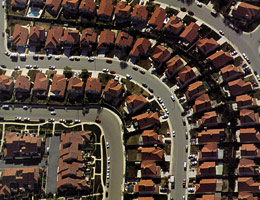Boomburb
The term Boomburb designates any urban area within a metropolitan region that fulfils the following requirements: 1. Not being the largest city in the region, 2. Having over 100,000 inhabitants, 3. Having annual growth rates of over 10% in the first ten years of its life. These determining factors mean that the use of the term so far has been restricted to areas of extraordinary economic effervescence, and that among these it has been applied preferably to the geographical context where it was forged and where it broke out. From 1950 to 2000, a total of 53 boomburbs have emerged in the United States, the immense majority of these being located in the Sunbelt in the southwest of the country.

According to Robert E. Lang, the director of urban research of the Fannie Mae Foundation, "Boomburbs are urban in fact, but not in feel." The boomburb is technically an urban entity, but its appearance is disconcerting: While latest-generation suburban growth is created in a similar way to the idealized image of its mother cities, i.e. mixing high- and low-density residences, central office areas, and streets used for commerce, this coherence is lost in the boomburb. As it does not have a dense core, it becomes an impossible amalgam of homes and business, trade, and leisure premises, far removed from any analogy with the traditional city. In a territorial context marked by the exhaustion of the center-periphery dialectics, the boomburb becomes an alternative suburban paradigm. The consequence of absolute indifferentiation is the disappearance of its edges, and the only limits for its growth are those set by its infrastructures: these include those of supply, especially water supply, which is the most vital in order to subsist in the generally arid climate, and those of transport, which make the private car the exclusive protagonist of mobility.
As a logical consequence of its explosive nature, not infrequently the planning of the boomburb is incapable of satisfying the huge demands, which means that the problems of supply and traffic congestion are as habitual as they are hard to resolve. Despite the great technological effort, after the explosion of the numbers these cities defined on the basis of quantitative parameters are reduced to bones joined by a small amount of skin, specters that paradoxically presage memories of underdevelopment.
Bibliography
- GARREAU, Joel. Edge City: Life on the New Frontier. New York: Doubleday, 1991